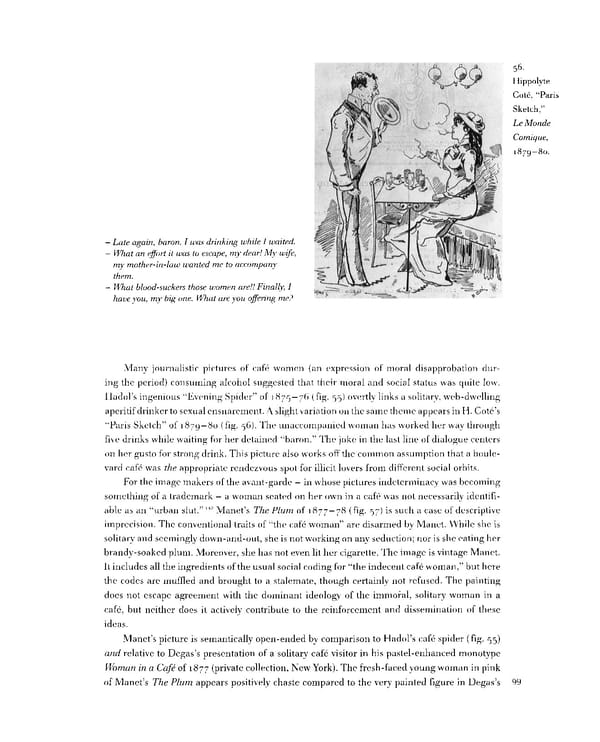56- Hippolyte Cote, "Paris Sketch," Le Monde Comique, 1879-80. • Late again, baron. I was drinking while I waited. • What an effort it was to escape, my dear! My wife, my mother-in-law wanted me to accompany them. • What blood-suckers those women are!! Finally, I have you, my big one. What are you offering me? Many journalistic pictures of cafe women (an expression of moral disapprobation dur- ing the period) consuming alcohol suggested that their moral and social status was quite low. Hadol's ingenious "Evening Spider" of 1875 — 76 (fig. 55) overtly links a solitary, web-dwelling aperitif drinker to sexual ensnarement. A slight variation on the same theme appears in H. Cote's "Paris Sketch" of 1879 — 80 (fig. 56). The unaccompanied woman has worked her way through five drinks while waiting for her detained "baron." The joke in the last line of dialogue centers on her gusto for strong drink. This picture also works off the common assumption that a boule- vard cafe was the appropriate rendezvous spot for illicit lovers from different social orbits. For the image makers of the avant-garde — in whose pictures indeterminacy was becoming something of a trademark — a woman seated on her own in a cafe was not necessarily identifi- able as an "urban slut." 142 Manet's The Plum of 1877 — 78 (fig. 57) is such a case of descriptive imprecision. The conventional traits of "the cafe woman" are disarmed by Manet. While she is solitary and seemingly down-and-out, she is not working on any seduction; nor is she eating her brandy-soaked plum. Moreover, she has not even lit her cigarette. The image is vintage Manet. It includes all the ingredients of the usual social coding for "the indecent cafe woman," but here the codes are muffled and brought to a stalemate, though certainly not refused. The painting does not escape agreement with the dominant ideology of the immoral, solitary woman in a cafe, but neither does it actively contribute to the reinforcement and dissemination of these ideas. Manet's picture is semantically open-ended by comparison to Hadol's cafe spider (fig. 55) and relative to Degas's presentation of a solitary cafe visitor in his pastel-enhanced monotype Woman in a Cafe of 1877 (private collection, New York). The fresh-faced young woman in pink of Manet's The Plum appears positively chaste compared to the very painted figure in Degas's 99
 Prostitution & Impressionists Page 119 Page 121
Prostitution & Impressionists Page 119 Page 121